One of the most common questions we get in the UK at the Home Lift Experts is: What are the main differences between a home lift and a stairlift?
Here we tackle some of the big questions, to help you make an informed decision.
INSTALLATION
A ‘through the floor’ home lift is one of the most versatile home mobility solutions on the market. Installed in under one day, some domestic lifts, such as those available from either Stiltz or Lifton, are built in module sections so the unit is easily transportable with no hydraulics or load bearing walls required. All the lift requires is a mains plug socket nearby for power and a home lift can be installed in almost any location of your choice with it typically travelling from hallway to landing or main living area up to master bedroom although the options are virtually limitless.
A stairlift is, as its name suggests, located on your stairs. It is better if your stairs are wider, as often it is not possible to pass on the stairs when the stairlift is in action and it can take up most of the width of the staircase. Narrow stairwells may also require railing removal. A stairlift is also always on show, whereas the most natural place for a home lift to be installed is in the corner of a living room or hallway – or it can be concealed if that is your preference, behind a cupboard or door. It usually takes between two and four hours to install a stairlift, however, a turning staircase can be much trickier and could take between one and two days.

DESIGN
A modern home lift is available in such appealing designs nowadays that most homeowners actually choose to have them on display in the centre of the room. That said, if you would like your domestic lift to blend in with a specific theme or scheme, most, such as the ones offered by Artico, can be fully customised to suit your requirements. Whilst seat covers and (sometimes) colours can be chosen for stairlifts, there is generally a lot less choice and the design elements do appear more clinical.

NOISE
Whilst both stairlifts and home lifts will make some noise, home lifts are considered to be generally quieter with some described as ‘whisper quiet’. Some do not even use hydraulics and are powered by simply plugging them into a mains power socket. A lift is designed to fit naturally within a home environment, so noise limitation forms an important part of the design and technology research process. The noise on a stairlift tends to come from the track that the chair is drawn along, with most feedback suggesting a grinding noise can be heard when the machine is in motion.
SPEED
Some home lifts can travel between floors smoothly in under 30 seconds whereas a stairlift’s speed is very slow, generally travelling between 0.16mph and 0.34mph.
PRICE
Home lifts are a larger investment than a stairlift, but can add value to a home. A house with a lift is appealing to a broad range of people and not just those seeking a retirement property. With more and more people living in inter-generational homes, a domestic lift opens out access to every level of the home in the easiest way.
Not only is a home lift perfect for those who find the stairs a challenge, but it is also great for carrying luggage, laundry, heavy boxes, even the baby (and all the other bits you need at the same time), golf clubs, you name it – it is highly versatile. A good quality stairlift starts around £5,000* and while they do offer a practical solution to getting up the stairs, they only accommodate one passenger, travelling alone, and that is the sole use. They can also be unsightly and eat into the space on your staircase. Most domestic lifts, however, are capable of taking two – sometimes three – people from floor to floor.
The prices indicated by the * are for non-Stiltz products types and as such the price is merely a guideline, for a more accurate cost you would have to contact a supplier of these products. Also, as these are estimates VAT may need to be added to them , depending on you VAT status.



Recent Comments